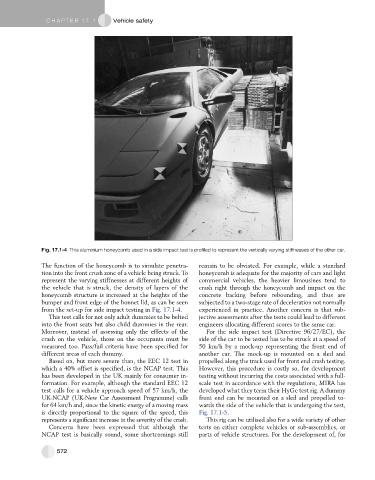Page 561 - Automotive Engineering Powertrain Chassis System and Vehicle Body
P. 561
CHAP TER 1 7. 1 Vehicle safety
Fig. 17.1-4 This aluminium honeycomb used in a side impact test is profiled to represent the vertically varying stiffnesses of the other car.
The function of the honeycomb is to simulate penetra- remain to be obviated. For example, while a standard
tion into the front crush zone of a vehicle being struck. To honeycomb is adequate for the majority of cars and light
represent the varying stiffnesses at different heights of commercial vehicles, the heavier limousines tend to
the vehicle that is struck, the density of layers of the crash right through the honeycomb and impact on the
honeycomb structure is increased at the heights of the concrete backing before rebounding, and thus are
bumper and front edge of the bonnet lid, as can be seen subjected to a two-stage rate of deceleration not normally
from the set-up for side impact testing in Fig. 17.1-4. experienced in practice. Another concern is that sub-
This test calls for not only adult dummies to be belted jective assessments after the tests could lead to different
into the front seats but also child dummies in the rear. engineers allocating different scores to the same car.
Moreover, instead of assessing only the effects of the For the side impact test (Directive 96/27/EC), the
crash on the vehicle, those on the occupants must be side of the car to be tested has to be struck at a speed of
measured too. Pass/fail criteria have been specified for 50 km/h by a mock-up representing the front end of
different areas of each dummy. another car. The mock-up is mounted on a sled and
Based on, but more severe than, the EEC 12 test in propelled along the track used for front end crash testing.
which a 40% offset is specified, is the NCAP test. This However, this procedure is costly so, for development
has been developed in the UK mainly for consumer in- testing without incurring the costs associated with a full-
formation. For example, although the standard EEC 12 scale test in accordance with the regulations, MIRA has
test calls for a vehicle approach speed of 57 km/h, the developed what they term their HyGe test rig. A dummy
UK-NCAP (UK-New Car Assessment Programme) calls front end can be mounted on a sled and propelled to-
for 64 km/h and, since the kinetic energy of a moving mass wards the side of the vehicle that is undergoing the test,
is directly proportional to the square of the speed, this Fig. 17.1-5.
represents a significant increase in the severity of the crash. This rig can be utilised also for a wide variety of other
Concerns have been expressed that although the tests on either complete vehicles or sub-assemblies, or
NCAP test is basically sound, some shortcomings still parts of vehicle structures. For the development of, for
572

